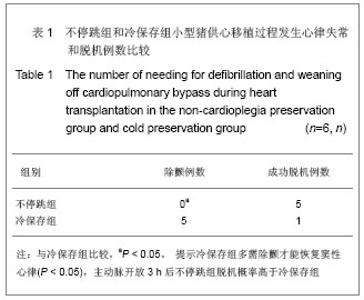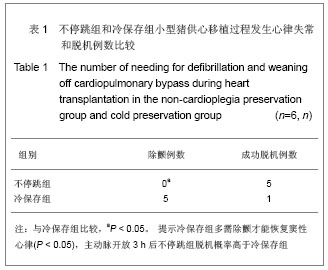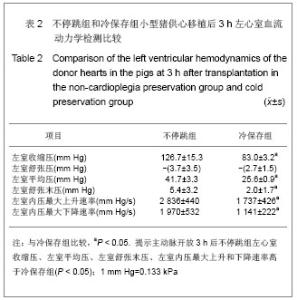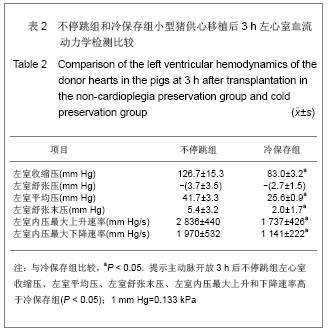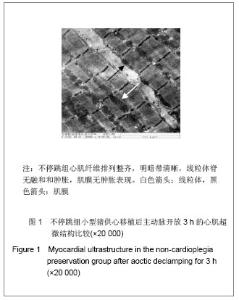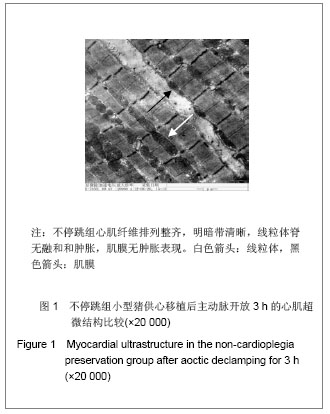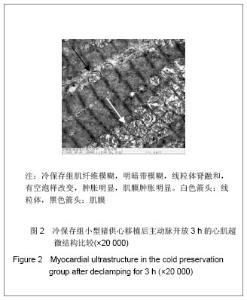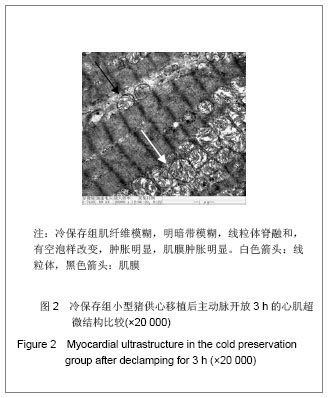Chinese Journal of Tissue Engineering Research ›› 2013, Vol. 17 ›› Issue (5): 851-858.doi: 10.3969/j.issn.2095-4344.2013.05.014
Previous Articles Next Articles
Myocardial ultrastructure and hemodynamic changes of donor heart preserved in normothemic beating status
Yang Yong1, Lin Hui1,2, Wen Zhao-ke2, Huang Ai-lan3, Wen Hong3, Huang Guo-yong3, Hu Yan-yan3, Zhong Yong-long1
- 1 Department of Cardiothoracic Surgery, Renmin Hospital of Wuhan University, Wuhan 430072, Hubei Province, China
2 Department of Cardiothoracic Surgery, People’s Hospital of Guangxi Zhuang Autonomous Region, Nanning 530021, Guangxi Zhuang Autonomous Region, China
3 Department of Anesthesiology, People’s Hospital of Guangxi Zhuang Autonomous Region, Nanning 530021, Guangxi Zhuang Autonomous Region, China
-
Received:2012-12-14Revised:2012-12-25Online:2013-01-29Published:2013-01-29 -
Contact:Lin Hui, Doctor, Doctoral supervisor, Professor, Chief physician, Department of Cardiothoracic Surgery, Renmin Hospital of Wuhan University, Wuhan 430072, Hubei Province, China; Department of Cardiothoracic Surgery, People’s Hospital of Guangxi Zhuang Autonomous Region, Nanning 530021, Guangxi Zhuang Autonomous Region, China linhui33622@sina.com -
About author:Yang Yong☆, Studying for doctorate, Department of Cardiothoracic Surgery, Renmin Hospital of Wuhan University, Wuhan 430072, Hubei Province, China yangyong2006150@163.com -
Supported by:National Natural Science Foundation of China, No.81060027
CLC Number:
Cite this article
Yang Yong, Lin Hui, Wen Zhao-ke, Huang Ai-lan, Wen Hong, Huang Guo-yong, Hu Yan-yan. Myocardial ultrastructure and hemodynamic changes of donor heart preserved in normothemic beating status[J]. Chinese Journal of Tissue Engineering Research, 2013, 17(5): 851-858.
share this article
| [1] Brink JG, Hassoulas J. The first human heart transplant and further advances in cardiac transplantation at Groote Schuur Hospital and the University of Cape Town - with reference to : the operation. A human cardiac transplant : an interim report of a successful operation performed at Groote Schuur Hospital, Cape Town. Cardiovasc J Afr. 2009;20(1): 31-35.[2] Hoerbelt R, Madsen JC. Feasibility of xeno-transplantation. Surg Clin North Am. 2004;84(1): 289-307.[3] Cooper DK, Ayares D. The immense potential of xenotransplantation in surgery. Int J Surg. 2011;9(2): 122-129.[4] Cooper DK, Teuteberg JJ. Pig heart xenotransplantation as a bridge to allotransplantation. J Heart Lung Transplant. 2010; 29(8): 838-840.[5] George JF. Xenotransplantation: an ethical dilemma. Curr Opin Cardiol. 2006;21(2): 138-141.[6] Kim JS, Lee HM, Oh BC,et al. Effect of hyperkalemia and hemolysis caused by hyperacute rejection on cardiac function in pig to human ex vivo xenogeneic cardiac perfusion model. Korean Circ J. 2011; 41(3): 130-136.[7] Byrne GW, Du Z, Sun Z, et al. Changes in cardiac gene expression after pig-to-primate orthotopic xenotransplantation. Xenotransplantation. 2011;18(1): 14-27.[8] Rivard AL, Gallegos RP, Bianco RW, et al. The basic science aspect of donor heart preservation: a review. J Extra Corpor Technol. 2004;36(3): 269-274.[9] Xie AN, Dong NG, Zhang KL, et al. Clinical experience in the use of marginal donor hearts. Chin Med J (Engl). 2011;124(8): 1185-1188.[10] Taylor DO, Edwards LB, Mohacsi PJ, et al. The registry of the International Society for Heart and Lung Transplantation: twentieth official adult heart transplant report--2003. J Heart Lung Transplant. 2003;22(6): 616-624.[11] Jahania MS, Mullett TW, Sanchez JA, et al. Acute allograft failure in thoracic organ transplantation. J Card Surg. 2000; 15(2): 122-128.[12] Rao V, Feindel CM, Cohen G, et al. Is profound hypothermia required for storage of cardiac allografts? J Thorac Cardiovasc Surg. 2001;122(3): 501-507.[13] Rivard AL, Hellmich C, Swingen CM, et al. Intermittent antegrade cardioplegia: isolated heart preservation with the Asporto heart preservation device. Prog Transplant. 2008; 18(2): 127-133.[14] Miyamoto H, Sunamori M, Suzuki A. Comparison of intermittent injection of nondepolarizing solution with a single flush of UW solution for donor heart preservation. Transpl Int. 1993;6(2): 63-68.[15] Zhang F, Mo A, Wen Z, et al. Continuous perfusion of donor hearts with oxygenated blood cardioplegia improves graft function. Transpl Int. 2010;23(11): 1164-1170.[16] Rosenbaum DH, Peltz M, DiMaio JM, et al. Perfusion preservation versus static preservation for cardiac transplantation: effects on myocardial function and metabolism. J Heart Lung Transplant. 2008;27(1): 93-99.[17] Charniot JC, Bonnefont-Rousselot D, Albertini JP, et al. Oxidative stress implication after prolonged storage donor heart with blood versus crystalloid cardioplegia and reperfusion versus static storage. J Surg Res. 2010;160(2): 308-314.[18] Fan Y, Zhang AM, Xiao YB, et al. Warm versus cold cardioplegia for heart surgery: a meta-analysis. Eur J Cardiothorac Surg. 2010;37(4): 912-919.[19] Abah U, Garfjeld Roberts P, Ishaq M, et al. Is cold or warm blood cardioplegia superior for myocardial protection? Interact Cardiovasc Thorac Surg. 2012;14(6): 848-855.[20] McConnell DH, Brazier JR, Cooper N, et al. Studies of the effects of hypothermia on regional myocardial blood flow and metabolsim during cardiopulmonary bypass. II. Ischemia during moderate hypothermia in continually perfused beating hearts. J Thorac Cardiovasc Surg. 1977;73(1): 95-101.[21] Yamamoto F. Do we need hypothermia in myocardial protection? Ann Thorac Cardiovasc Surg. 2000;6(4): 216-223.[22] Jamieson RW, Friend PJ. Organ reperfusion and preservation. Front Biosci. 2008;13: 221-235.[23] Weisel RD. Improving donor heart preservation. Eur J Cardiothorac Surg. 2012;41(4): e53-55.[24] Lin H, Mo A, Zhang F, et al. Donor heart preservation in an empty beating state under mild hypothermia. Ann Thorac Surg. 2010;89(5): 1518-1523.[25] Rubino AS, Serraino GF, Mariscalco G, et al. Leukocyte depletion during extracorporeal circulation allows better organ protection but does not change hospital outcomes. Ann Thorac Surg. 2011;91(2): 534-540.[26] Dvorak L, Pirk J, Cerny S, et al. The role of leukocyte depleting filters in heart transplantation: early outcomes in prospective, randomized clinical trial. Eur J Cardiothorac Surg. 2006;30(4): 621-627.[27] Mo AS, Zhang F, He BF, et al. Zhonghua Qiguan Yizhi Zazhi. 2009;30(11): 697-698.莫安胜, 张帆, 贺榜福,等. 广西巴马小型猪标准原位心脏移植模型的建立[J]. 中华器官移植杂志, 2009, 30(11): 697-698.[28] Luciani GB, Forni A, Rigatelli G, et al. Myocardial protection in heart transplantation using blood cardioplegia: 12-year outcome of a prospective randomized trial. J Heart Lung Transplant. 2011;30(1): 29-36.[29] Poston RS, Gu J, Prastein D, et al. Optimizing donor heart outcome after prolonged storage with endothelial function analysis and continuous perfusion. Ann Thorac Surg. 2004; 78(4): 1362-1370;discussion 1362-1370.[30] Zheng M, Song JF, Yang F, et al. Zhongguo Zuzhi Gongcheng Yanjiu yu Linchuang Kangfu. 2011;15(53): 9996-9998.郑民, 宋剑非, 杨峰,等. 猪不停跳心脏离体模型的建立[J]. 中国组织工程研究与临床康复, 2011, 15(53) : 9996-9998. [31] Garbade J, Krautz C, Aupperle H, et al. Functional, metabolic, and morphological aspects of continuous, normothermic heart preservation: effects of different preparation and perfusion techniques. Tissue Eng Part C Methods. 2009;15(2): 275-283.[32] Jacobs S, Rega F, Meyns B. Current preservation technology and future prospects of thoracic organs. Part 2: heart. Curr Opin Organ Transplant. 2010;15(2): 156-159.[33] LeBoutillier M 3rd, Grossi EA, Steinberg BM, et al. Effect of retrograde warm continuous cardioplegia on right ventricular function. Circulation. 1994;90(5 Pt 2): II306-309.[34] Schaper J, Walter P, Scheld H, et al. The effects of retrograde perfusion of cardioplegic solution in cardiac operations. J Thorac Cardiovasc Surg. 1985;90(6): 882-887.[35] Horvath KA, Corcoran PC, Singh AK, et al. Left ventricular pressure measurement by telemetry is an effective means to evaluate transplanted heart function in experimental heterotopic cardiac xenotransplantation. Transplant Proc. 2010;42(6): 2152-2155.[36] Gallup CJ, Cabreriza SE, Hart JP, et al. Left ventricular end-diastolic volume from ejection fraction and stroke volume in pigs during IVC occlusion. J Surg Res. 2002;106(1): 76-81.[37] Ferrans VJ. Morphological methods for evaluation of myocardial protection. Ann Thorac Surg. 1975;20(1): 11-20.[38] Rivard AL, Gallegos R, Ogden IM, et al. Perfusion preservation of the donor heart: basic science to pre-clinical. J Extra Corpor Technol. 2009;41(3):140-148.[39] Lou S, Ji B, Liu J, et al. Generation, detection and prevention of gaseous microemboli during cardiopulmonary bypass procedure. Int J Artif Organs. 2011;34(11): 1039-1051.[40] Apostolakis E, Filos KS, Koletsis E, et al. Lung dysfunction following cardiopulmonary bypass. J Card Surg. 2010;25(1): 47-55.[41] Levy JH, Tanaka KA. Inflammatory response to cardiopulmonary bypass. Ann Thorac Surg. 2003;75(2): S715-720.[42] Gurbanov E, Meng X, Cui Y, et al. Evaluation ECMO in adult cardiac transplantation: can outcomes of marginal donor hearts be improved? J Cardiovasc Surg (Torino). 2011;52(3): 419-427. |
| [1] | Yang Xin, Jin Zhe, Feng Xu, Lu Bing. The current situation of knowledge and attitudes towards organ, eye tissue, body donation of residents in Shenyang [J]. Chinese Journal of Tissue Engineering Research, 2021, 25(5): 779-784. |
| [2] | Wang Jing, Wu Jiangbo. Irisin mediates protective effects on failing heart via integrin alpha V receptors [J]. Chinese Journal of Tissue Engineering Research, 2021, 25(20): 3219-3225. |
| [3] | Zhao Chuntao, Qing Mingsong, Yu Langbo, Peng Jiachen . Meta-analysis of total knee arthroplasty guided by kinematic alignment and mechanical alignment [J]. Chinese Journal of Tissue Engineering Research, 2020, 24(9): 1435-1442. |
| [4] |
Zhang Cong, Zhao Yan, Du Xiaoyu, Du Xinrui, Pang Tingjuan, Fu Yining, Zhang Hao, Zhang Buzhou, Li Xiaohe, Wang Lidong.
Biomechanical analysis of the lumbar spine and pelvis in adolescent
idiopathic scoliosis with lumbar major curve |
| [5] | Qiao Yuqi, Fu Rongchang, Zhang Lihong. Effects of sand therapy on hemodynamics in the femoral artery bifurcation at different degrees of stenosis [J]. Chinese Journal of Tissue Engineering Research, 2020, 24(8): 1218-1224. |
| [6] |
Cen Yanhui, Xia Meng, Jia Wei, Luo Weisheng, Lin Jiang, Chen Songlin, Chen Wei, Liu Peng, Li Mingxing, Li Jingyun, Li Manli, Ai Dingding, Jiang Yunxia.
Baicalein inhibits the biological behavior of hepatocellular
carcinoma stem cells by downregulation of Decoy receptor 3 expression |
| [7] | He Yujie, Wang Haiyan, Li Zhijun, Li Xiaohe, Cai Yongqiang, Dai Lina, Xu Yangyang, Wang Yidan, Xu Xuebin. Digital measurements of the anatomical parameters of pedicle-rib unit screw fixation in thoracic vertebrae of preschoolers [J]. Chinese Journal of Tissue Engineering Research, 2020, 24(6): 869-876. |
| [8] | Yan Shu, Lu Yan, Ouyang Zhaolian. Analysis of programs on tissue engineering funded by the National Natural Science Foundation of China between 2013 and 2018 [J]. Chinese Journal of Tissue Engineering Research, 2020, 24(5): 731-735. |
| [9] | Sun Jian, Fang Chao, Gao Fei, Wei Laifu, Qian Jun. Clinical efficacy and complications of short versus long segments of internal fixation for the treatment of degenerative scoliosis: a meta-analysis [J]. Chinese Journal of Tissue Engineering Research, 2020, 24(3): 438-445. |
| [10] | Gao Yangyang, Che Xianda, Han Pengfei, Liang Bin, Li Pengcui. Accuracy of robot-assisted and fluoroscopy-guided pedicle screw placement: a meta-analysis [J]. Chinese Journal of Tissue Engineering Research, 2020, 24(3): 446-452. |
| [11] | Zhang Jian, Wang Xiaojian, Qin Dean, Zhao Zhongtao, Liang Qingyuan, An Qijun, Song Jiefu. Risk factors for proximal junctional kyphosis after spinal deformity surgery: a meta-analysis [J]. Chinese Journal of Tissue Engineering Research, 2020, 24(3): 460-468. |
| [12] | Xu Yangyang, Zhang Kai, Li Zhijun, Zhang Yunfeng, Su Baoke, Wang Xing, Wang Lidong, Wang Yidan, He Yujie, Li Kun, Wang Haiyan, Li Xiaohe. Morphological analysis of optimal selection of lumbar pedicle screws in adolescents aged 12-15 years [J]. Chinese Journal of Tissue Engineering Research, 2020, 24(21): 3321-3328. |
| [13] | He Xiaoming, Gong Shuidi, Zheng Xiaolong, Shen Yingshan, Pang Fengxiang, Chen Lixin, Li Weifeng, Yang Fan, Liu Shaojun, He Wei, Wei Qiushi. Trends in global research on bone and joint tuberculosis: bibliometrics and visual analysis [J]. Chinese Journal of Tissue Engineering Research, 2020, 24(20): 3234-3239. |
| [14] | Qin Haikuo, Luo Shixing. Correlation of cortical bone thickness and X-ray gray value in different planes of proximal femur with brittle fracture of female hip [J]. Chinese Journal of Tissue Engineering Research, 2020, 24(18): 2867-2872. |
| [15] | Wu Yuhang, Zheng Liqin, Zhang Biao, Li Fan, Chen Xinmin, Li Musheng, Zheng Yongze, Lin Ziling. Compression fracture simulation of osteoporotic trabecular bone in ovariectomized rats [J]. Chinese Journal of Tissue Engineering Research, 2020, 24(15): 2387-2392. |
| Viewed | ||||||
|
Full text |
|
|||||
|
Abstract |
|
|||||
